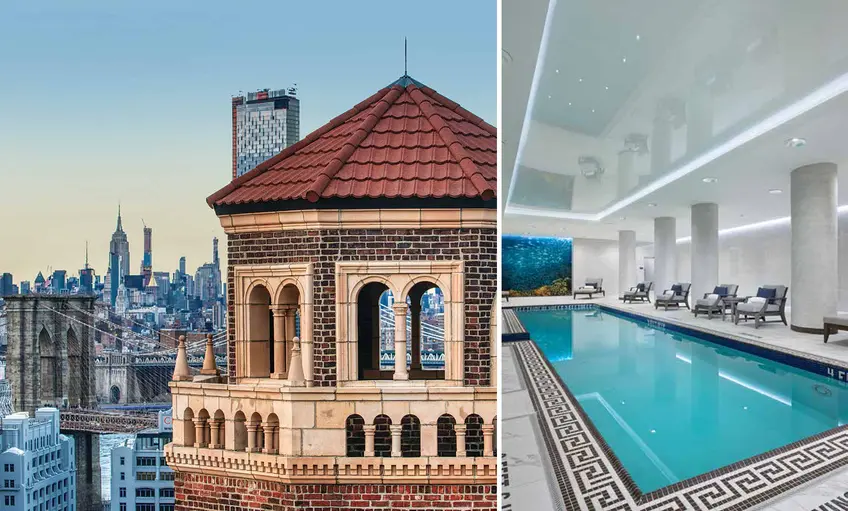 Brooklyn Heights' Leverich Towers Hotel has been transformed into a luxurious senior residence (The Watermark at Brooklyn Heights via Barry Hyman)
Brooklyn Heights' Leverich Towers Hotel has been transformed into a luxurious senior residence (The Watermark at Brooklyn Heights via Barry Hyman)
New York City has long been a magnet for the young, but in the 21st century, it has also become a magnet for the old. Between 2007 and 2017, the number of residents over 65 increased in all five boroughs. In Manhattan, the trend has been especially notable. According to a 2019 study carried out by the Center for an Urban Future, there are now more residents ages 65 and above in Manhattan than there are people under the age of 19.
In 2017, the World Health Organization and AARP named New York the first age-friendly state in the nation. More recently, Governor Kathy Hochul signed an executive order to create the state's first-ever Master Plan for Aging. It directs the Commissioner of the State Department of Health and the Director of the State Office for Aging to head a Master Plan for Aging Council, which will gather input from relevant stakeholders to build communities and enact policies that will allow older New Yorkers to age with dignity and independence.
In 2017, the World Health Organization and AARP named New York the first age-friendly state in the nation. More recently, Governor Kathy Hochul signed an executive order to create the state's first-ever Master Plan for Aging. It directs the Commissioner of the State Department of Health and the Director of the State Office for Aging to head a Master Plan for Aging Council, which will gather input from relevant stakeholders to build communities and enact policies that will allow older New Yorkers to age with dignity and independence.
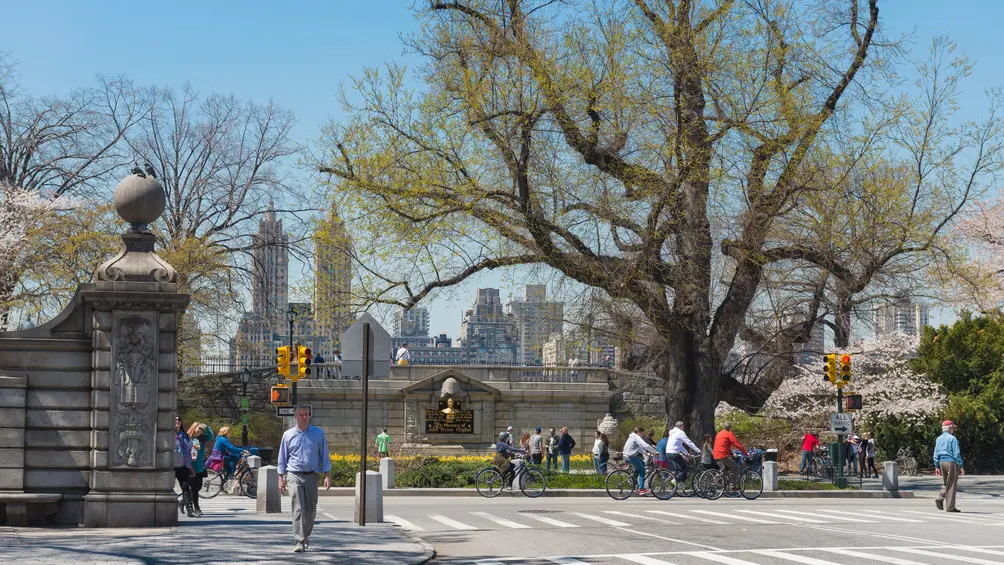 Central Park near the Jackie O Reservoir
Central Park near the Jackie O Reservoir
In this article:
'...there is growing evidence that retiring in the city, especially in a high-density neighborhood, can help extend one’s years of independent living.'
The order comes at a time when many are making the decision to retire in New York City rather than upstate New York, Palm Springs, or Miami. This may seem surprising to some, but there is growing evidence that retiring in the city, especially in a high-density neighborhood, can help extend one’s years of independent living. First, living in a full-service elevator building is generally much easier than living in a home in a rural or remote area. After all, in a doorman building, you’ll never have to worry about shoveling the steps, raking leaves, or warding off unwanted visitors. City life also offers a host of services that can help older adults remain independent well into their 90s. Indeed, New York's status as the first age-friendly state was determined by eight factors that include housing, transportation, community and health services, outdoor spaces and buildings, and social inclusion.
New York City’s graying profile primarily reflects two factors. First, most people born during the post-World War II baby boom are now over 65, and second, New Yorkers, like people around the world, are living longer than ever before. However, the city’s graying profile also reflects one more surprising trend—people are increasingly choosing to retire in the city. But if retiring in New York City is the right choice, should retirees buy or rent? This article will offer guidance in that regard, as well as a look at senior housing on the horizon.
Pros and Cons of Buying as a Retiree in NYC
If you’re lucky enough to be in a position to buy in New York City, there are many reasons to do so. First, buying as a retiree comes with the same benefits that buying offers at any other stage of life—more security, stability, and equity. In other words, you won’t need to deal with sudden rental increases, negligent landlords, or any of the other problems that can accompany life as a renter.
Second, if you can afford to buy in New York City, you may find your net worth growing rather than depleting after you retire. Even with the downturn in the market, data
on Manhattan apartments reveals that over the past 20 years, Manhattan properties have seen price increases between 85% and 121.8%. Few retirement investment funds can match such returns. So, at least on the surface, investing in New York City real estate may be an option to grow one’s equity after retirement. Whether one plans to tap into the equity later or wants to leave a bit more for their children or grandchildren, this is a good thing. But there is one thing retirees must consider.
Prior to the outgoing administration’s overhaul of federal tax laws, it was possible to deduct state and local taxes, including property taxes. Naturally, people living in regions of the country with high housing taxes, such as New York City, had the most to gain from this specific tax break. With state and local taxes (SALT)
no longer deductible, owning versus renting has become considerably less attractive, especially for retirees on fixed incomes.
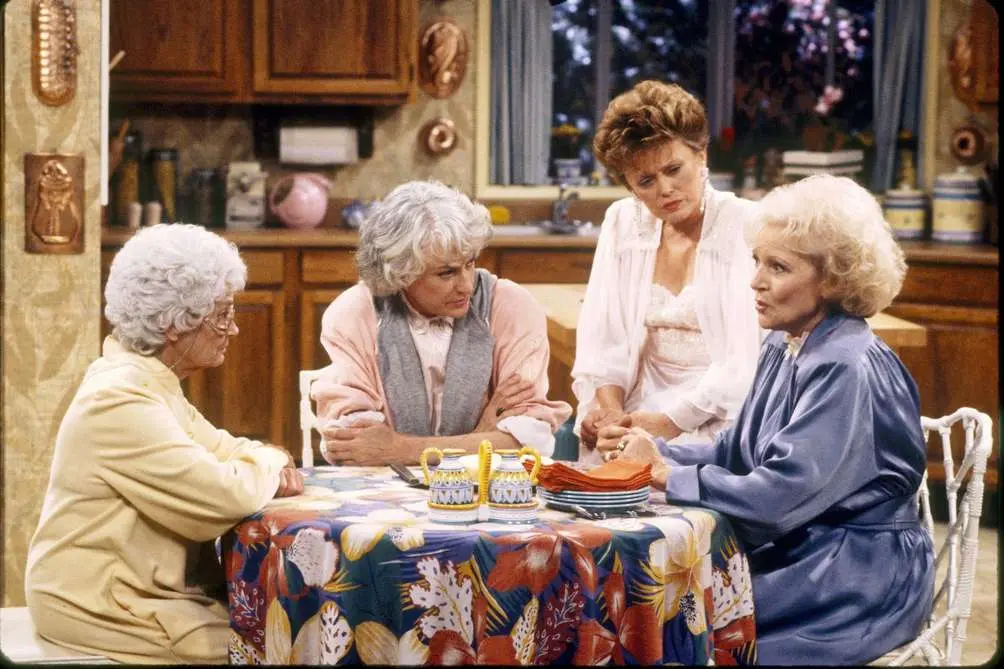 More seniors are deciding not to move to slow-paced, warmer climates. The Golden Girls Source: NBC
More seniors are deciding not to move to slow-paced, warmer climates. The Golden Girls Source: NBC
Pros and Cons of Renting as a Retiree in NYC
If you’ve owned a home for decades, renting may seem counter-intuitive. Still, renting in New York City may make more sense than buying under some circumstances.
As a rule of thumb, buying in New York City is a stable investment likely to yield a return, but only if you plan to hold your property for at least twelve years. While New York City properties are unlikely to deplete in value over the course of a decade, the process of buying in New York City is an investment itself. Broker and legal fees are higher than they are in most other regions of the country. Also, if you purchase a property worth more than $1 million, which is likely if you’re buying in Manhattan, you’ll pay a mansion tax. As a result, unless you’re thinking long term (holding your property for over a decade), renting is generally a smarter financial move.
Another potential reason to rent rather than buy has to do with convenience and flexibility. Renting can bring its own hassles, but if you’re renting in a full-service building from a reliable management company, you should be able to take some things for granted. To begin, you’ll never need to worry about footing the bill for expensive repairs or appliance replacements. Also, if and when your circumstances change, you’ll be free to move into a new apartment or different type of living arrangement with little lead-up time.
The bottom line is that the decision to buy versus rent in New York City as a retiree is a decision that can only be made by carefully weighing key factors. First, it is important to consider how long you intend to live in New York City. Second, it is also important to consider how much money you can bring to a potential purchase. In fact, if you are over 60, many lenders will not even consider 80% financing on a property. If you can purchase, other factors, including your tax liability, also need to be taken into account.
Affordable Housing Lotteries for Seniors
Retiring affordably has been one of New York City's seemingly insurmountable challenges. However, recent mayoral administrations have been building developments geared towards low- and middle-income seniors. An affordable housing lottery is currently underway for 86 senior housing units at The Norfolk, the new development that rose on the former site of Beth Hamedrash Hagodol, the Lower East Side synagogue that was destroyed in a fire in 2017. A full floor of amenities will include a lounge, game room, fitness center, and social services office.
The deadline to apply at The Norfolk is December 5, 2022, and further details and criteria may be found here. Senior housing lotteries are also taking place in the Parkchester, Tremont, and Bedford Park sections of the Bronx as of this writing.
The deadline to apply at The Norfolk is December 5, 2022, and further details and criteria may be found here. Senior housing lotteries are also taking place in the Parkchester, Tremont, and Bedford Park sections of the Bronx as of this writing.
60 Norfolk Street
86 senior housing units | Deadline December 5, 2022
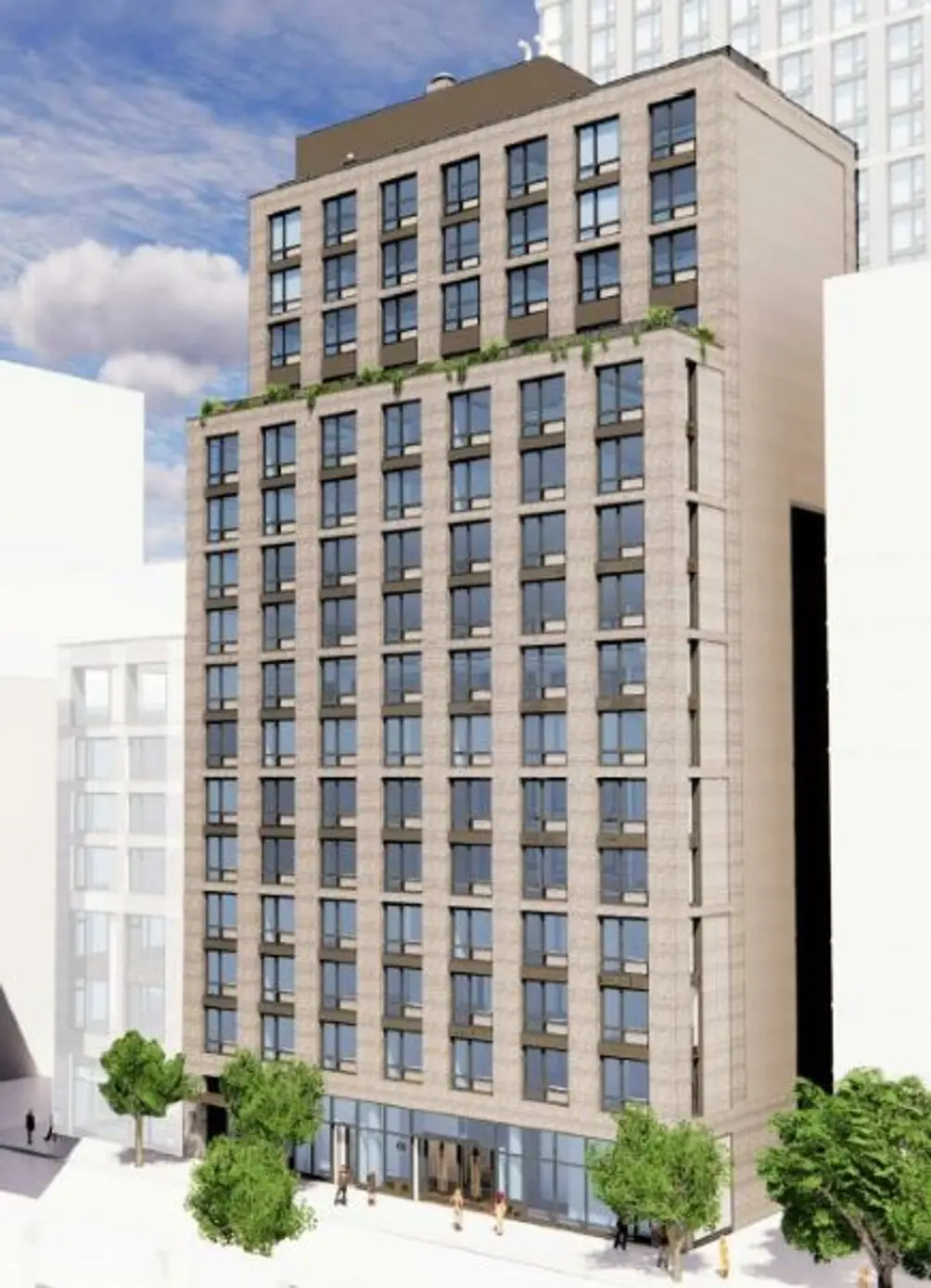
 Lottery criteria via Housing Connect
Lottery criteria via Housing Connect
The Norfolk building provides affordable apartments for seniors in a 16-story volume, including a full floor suite with a lounge, game room, yoga/activity room, and a social services office. Additional project amenities include a community room and outdoor roof terraces, security cameras in common areas, microwave, onsite superintendent. Individuals or households with at least 1 household member who is 62 years of age or older at the time of the application who meet the income and household size requirements listed in the table below may apply. There is a preference for residents of Manhattan Community Board 3.
Parkchester Gardens
1701 Purdy Street
153 senior housing units | Deadline December 14, 2022
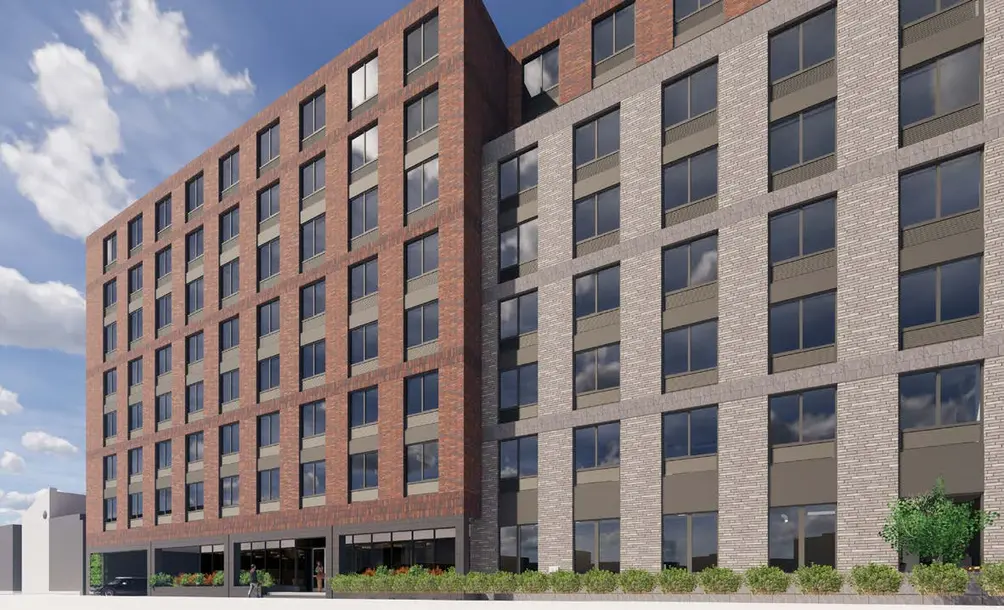

This building is being constructed through the Extremely Low and Low-Income Affordability (ELLA) program of the New York City Housing Development Corporation (HDC) and the Senior Affordable Rental Apartment (SARA) program of the New York City Department of Housing Preservation and Development (HPD). Individuals or households that have at least one household member who is 62 years of age or older may apply.
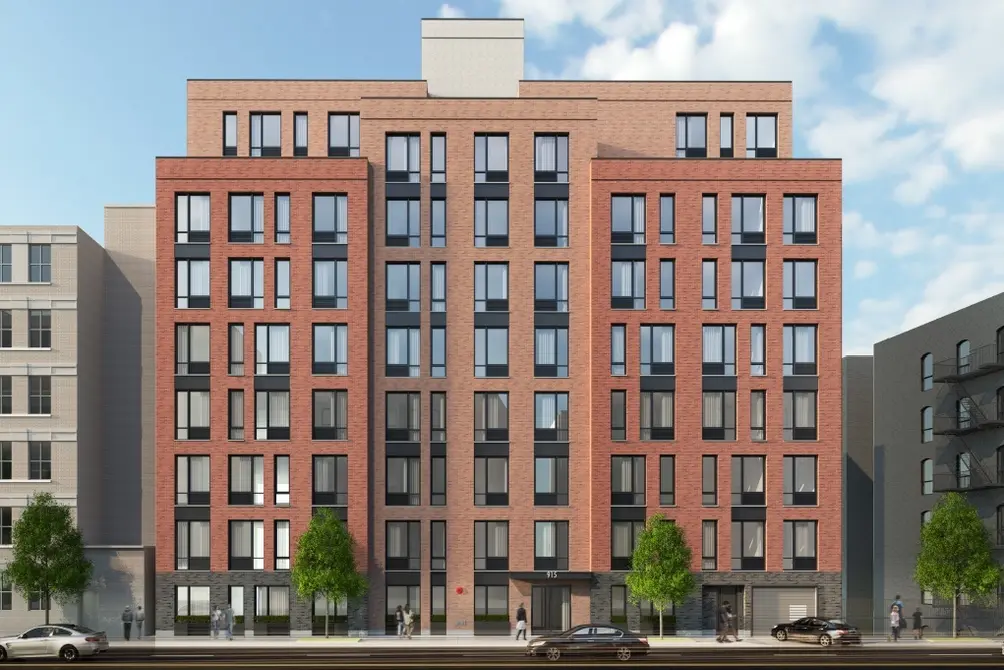
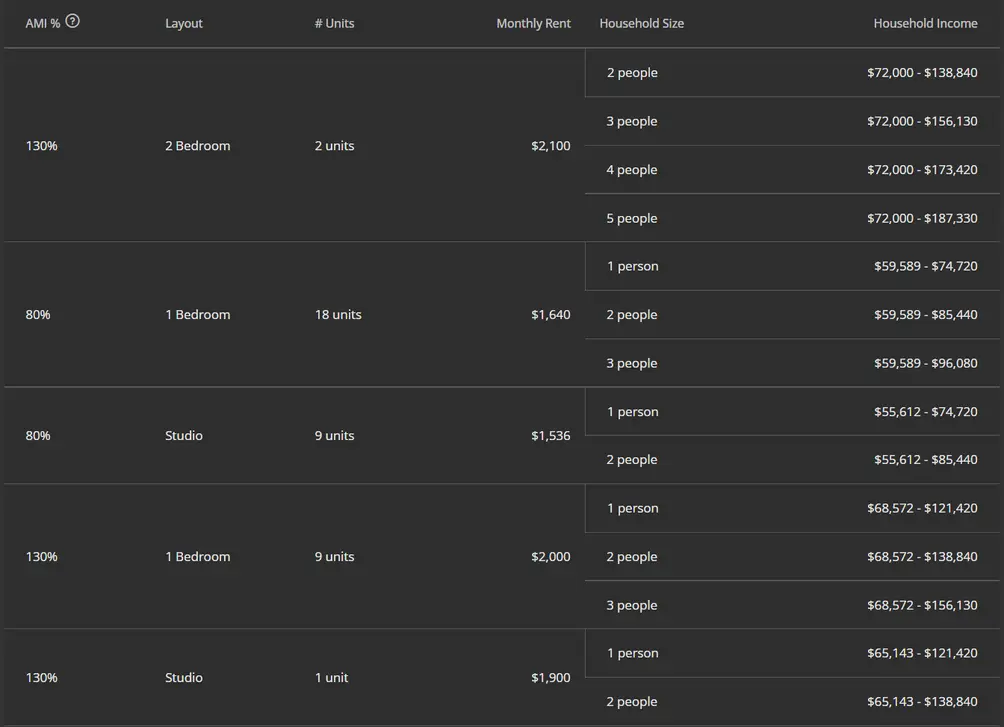
This building is being constructed through the Privately Financed Affordable Senior Housing(PFASH) Program of the New York City Department of Housing Preservation and Development and is anticipated to receive a Tax Exemption through the 421-a Program of the New York City Department of Housing Preservation and Development. Tenants will have access to the fitness center, recreational area and an on-site laundry room. This building is pet friendly and is smoke free. Parking and laundry room are subject to fees. For units where the income limit is set at 80% AMI Individuals or households must have at least one household member who is 62 years or older, and must meet the income and household size requirements that are listed below. For units where the income limit is set at 130% AMI, eligible individuals or households do not require a member that is 62 years of age or older.
2850 Webster Avenue, Bedford Park
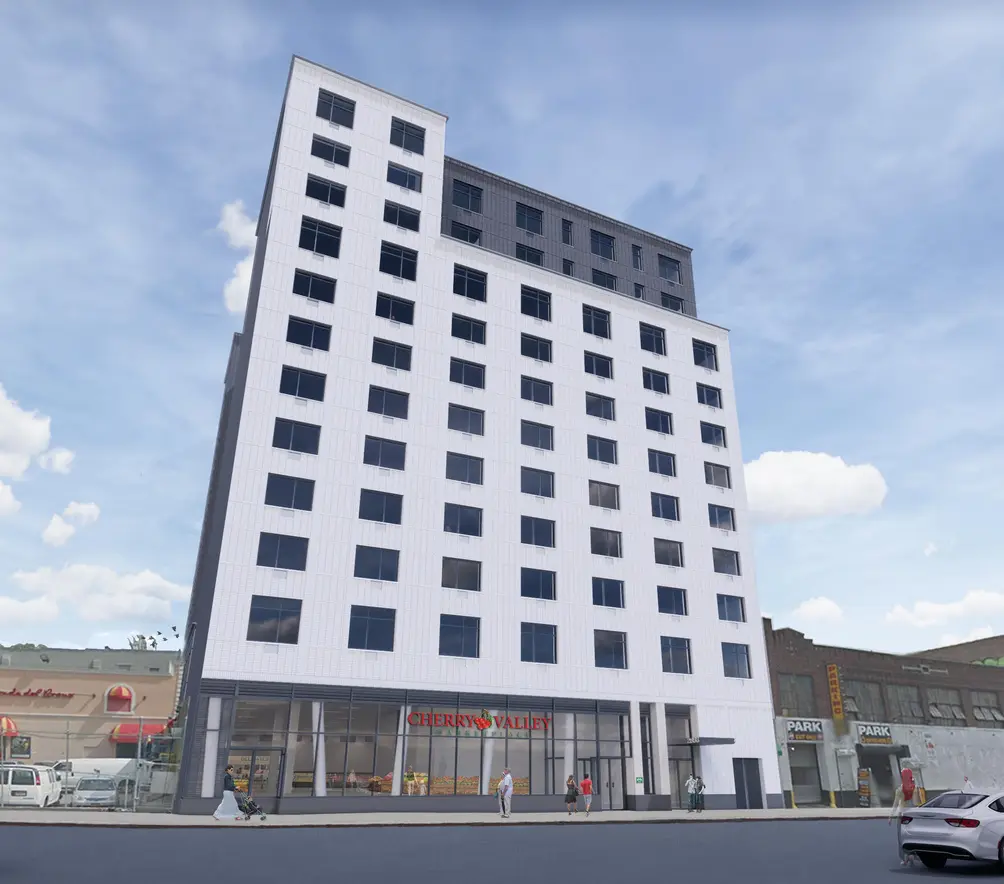

Apartments Program (SARA) of the New York City Department of Housing Preservation and Development, and financing from the New York State Division of Housing and Community Renewal. Individuals or households must meet the minimum age requirement of at least 62 years of age at the time of application submission and must qualify for section 8.
Senior Living Communities
One growing option attractive to seniors who prefer to rent in Manhattan is senior living communities. While these facilities have long existed, several more high-end developments are opening in desirable sections of Manhattan. These buildings often provide a full suite of amenities, concierge services, and trained staff attuned to senior care.
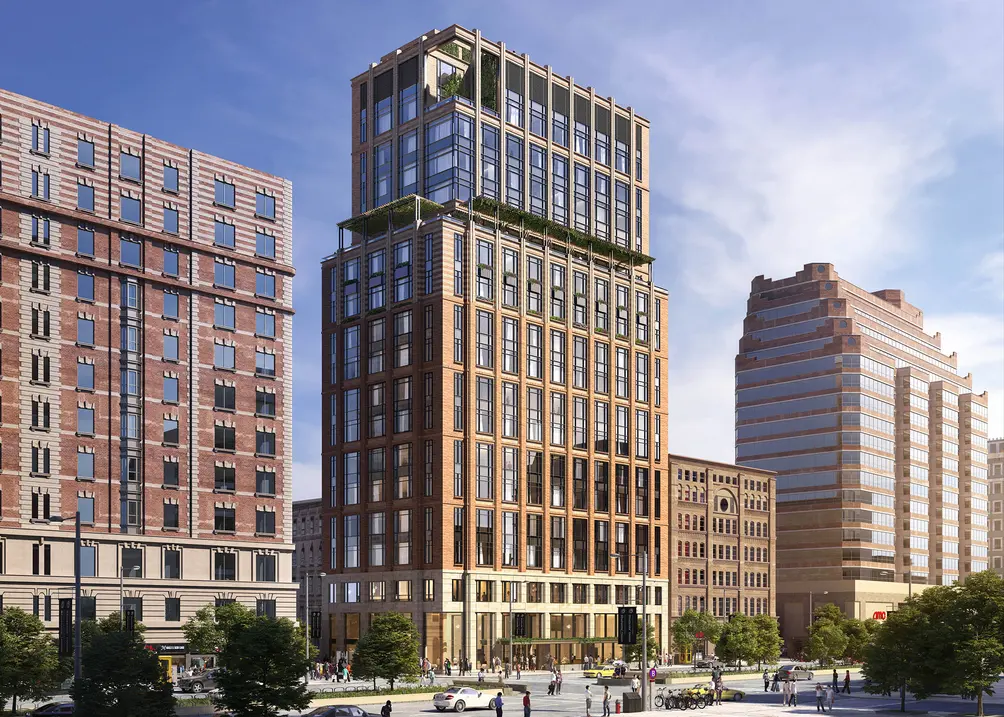 2330 Broadway, a new luxury senior housing building underway on the Upper West Side.
2330 Broadway, a new luxury senior housing building underway on the Upper West Side.
One such community is Inspīr Carnegie Hill on the Upper East Side. Developed by Maplewood Senior Living, the building offer 15,000 square feet of amenity spaces like a farm-to-table restaurant, a 16th-floor “sky park,” a swimming pool, fitness center, a library and other common areas for residents to mingle. The official leasing website explains that Inspir Carnegie Hill intends to draw energy from the surrounding neighborhood, and the residences are energized by nature—making ample use of organic materials, green spaces, and sunlight.
On the opposite side of Central Park, construction is winding down on a state-of-the-art senior living and memory care facility at 2330 Broadway. It is located on the corner of West 85th Street in a charming, convenient section of the Upper West Side, but residents may find all they need in the building: Amenities are set to include a spa, homeopathic care center, rooftop garden, and "bistro" where residents can gather for meals and activities.
Across the East River, Watermark in Brooklyn Heights offers 275 residences and over 50,000 square feet of resort-caliber amenities. The facility maintains a COVID-19 free environment by limiting building access to a single point of entry and all visitors and associates are screened daily. Occupants abide by universal masking policy and the care team promotes effective hand washing techniques and has deployed hand sanitizing stations throughout the facility. Innovative activities introduced to keep residents happy and sharp include virtual talent shows, distanced hallway dance parties, virtual reality for delivering events, and outdoor activities on the building's rooftop terrace.
Below are several new senior living options throughout the city.
Recently Opened
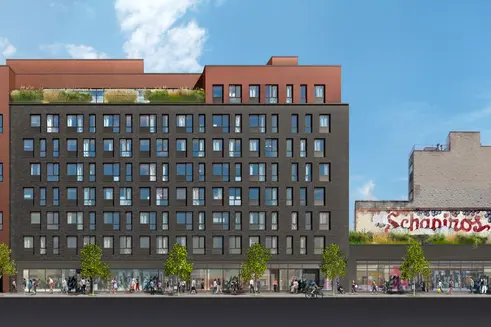
Essex Crossing - 140 Essex Street
Neighborhood: Lower East SIde
Building Type: Affordable Senior Living Rental
Developer: Delancey Street Associates
Designer: Beyer Blinder Belle
Senior housing was a key component of the Essex Crossing mega-development on the Lower East Side, and an affordable lottery for 84 units at 140 Essex Street took place in 2019. Amenities include a fitness center, lounge, outdoor terrace, bike room, and laundry room. Residents also have access to the new state-of-the-art senior center run by Grand Street Settlement at the nearby Frances Goldin Senior Apartments.
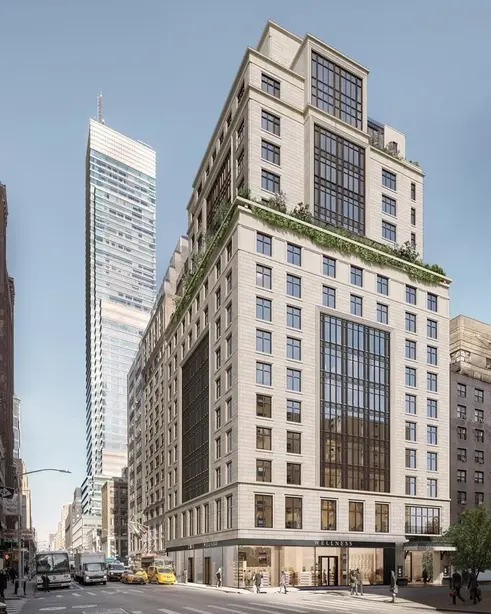 Sunrise East 56th Street (Hines/Welltower)
Sunrise East 56th Street (Hines/Welltower)
Sunrise at East 56th
Neighborhood: Midtown East
Building Type: Senior Living Community
Developer: Hines/Welltower Inc.
Designer: SLCE Architects
Located at 139 East 56th Street, Sunrise at East 56th is a new community designed for Manhattan seniors. The building provides attentive, trained staff, personalized assisted living and memory care in an impeccably detailed environment. Best-in-class amenities include restaurant-style dining, a partnership with the Museum of Modern Art, cultural outings throughout the city, an art studio, a hair salon, and three upper-story terraces. The building has achieved LEED Silver certification, WELL certification, and a WELL Health-Safety rating seal for its built-in safety features.
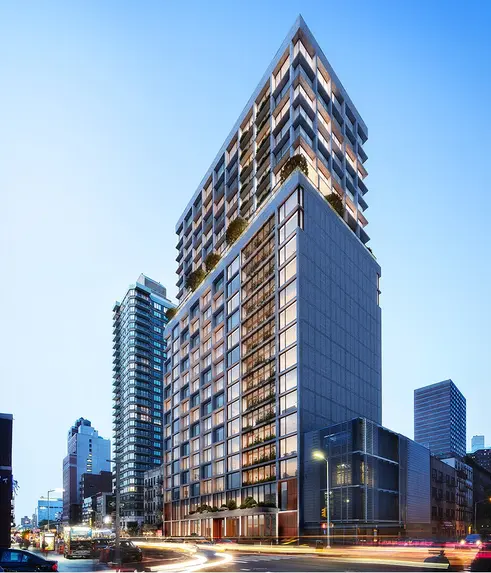 Rendering of Inspir Carnegie Hill (Handel Architects)
Rendering of Inspir Carnegie Hill (Handel Architects)
Inspir Carnegie Hill
Neighborhood: Carnegie Hill
Building Type: Senior Living Community
Developer: Maplewood Senior Living
Designer: Handel Architects
When Inspir Carnegie Hill was under construction, the developer of the 23-story, 215-unit building was already fielding calls from potential residents. The Connecticut-based senior living company already has 14 facilities in suburban areas but this Upper East Side project represents its first urban development.
The resident units are designed to maximize natural light and will include floor-to-ceiling windows, specially selected finishes, and features like built-in kitchenettes, wardrobes, marble bathrooms, and natural wood floors. A signature amenity will be the “sky park,” a landscaped terrace perched 150 feet above street level. It will feature trees reaching 20 feet tall and views overlooking the East River. Additional offerings include a farm-to-table restaurant, pool, fitness center, salon and spa, library, screening room, and art room. The building has achieved LEED Silver certification, and recently became one of New York’s first buildings in the assisted living sector to achieve the WELL Health-Safety rating.
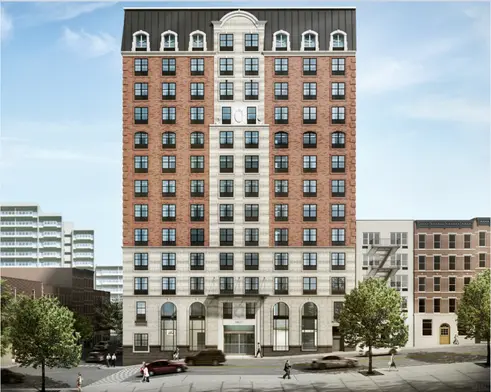 1622 York Avenue
1622 York Avenue
The Bristal Assisted Living, 1622 York Avenue
Neighborhood: Yorkville
Building Type: Senior Living Community
Developer: Engel Burman Group
Designer: H2M Architects + Engineers
The Bristal at York Avenue offers independent living, assisted living, and memory care in the Yorkville neighborhood of the Upper East Side. Sited just one block from Carl Schurz Park and two avenues away from the newly refurbished 86th Street subway station, the building houses a treatment center, fitness room, beauty salon, and dining space. There are also common spaces and offices on each floor.
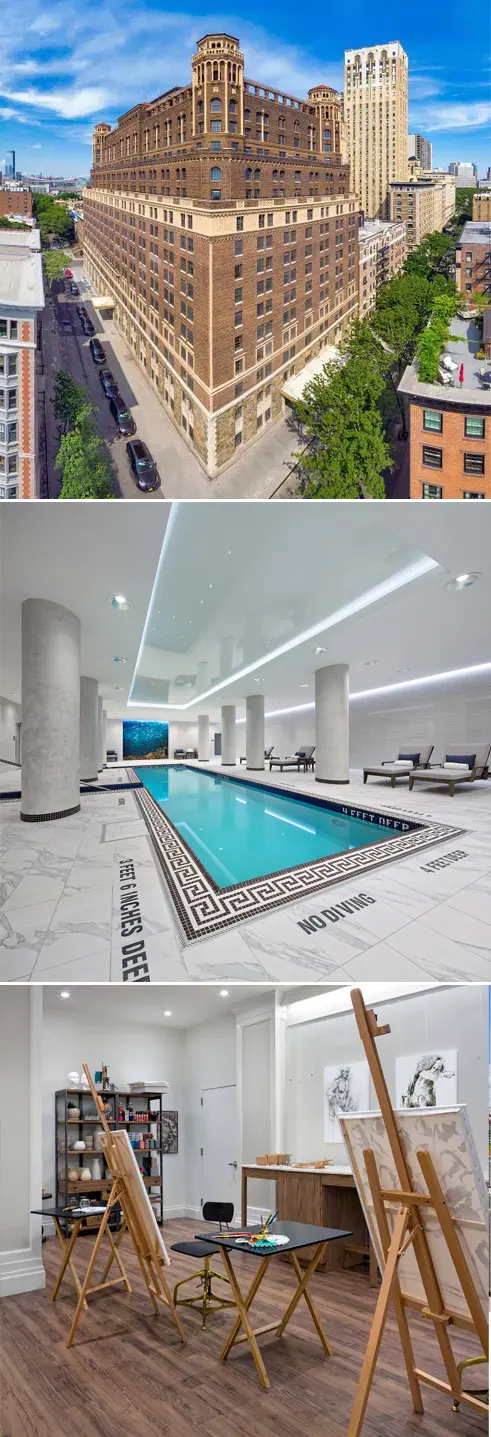 via The Watermark at Brooklyn Heights
via The Watermark at Brooklyn Heights
The Watermark at Brooklyn Heights
Neighborhood: Brooklyn Heights
Building Type: Senior Living Community
Developer: Watermark Retirement Communities and Kayne Anderson Real Estate
Designer: Montroy DeMarco Architecture
After an extensive renovation, The Watermark at Brooklyn Heights has welcomed its first residents to New York’s first luxury retirement community in 20 years and the first in Brooklyn. The building offers 275 stylish apartments and over 50,000 square feet of resort-caliber amenities, but its greatest perk may be its address in the heart of the Brooklyn Heights Historic District at 21 Clark Street.
The studio through two-bedroom apartments comprise 145 independent living apartments, 88 assisted living units, and 42 memory care units. The original mahogany-trimmed windows were incorporated into the design and allow residents to enjoy incredible views and natural light. Interiors by Andres Escobar feature open floor plans, designer kitchen or kitchenettes, and modern baths with walk-in showers. All residents benefit from two levels of leisure amenities that include a beauty salon, spa, creative arts studio, movement studio, movie theater, and performing arts center. Lower-level wellness amenities include a fitness studio, movement room for group fitness classes, warm-water therapy pool, and wellness center.
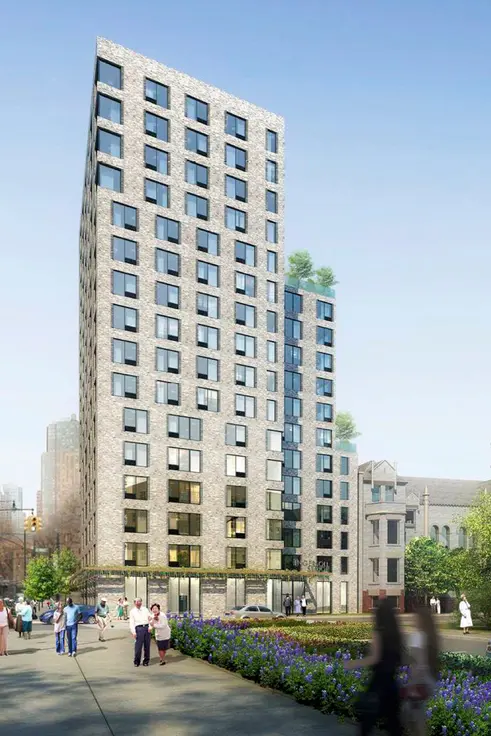 Ingersoll Senior Residences (Marvel Architects)
Ingersoll Senior Residences (Marvel Architects)
Stonewall House
Neighborhood: Fort Greene
Building Type: Affordable Senior Community
Developers: BFC Partners and SAGE
Designer: Marvel Architects
Located at 112 Edwards Street in Fort Greene, Stonewall House is New York's first LGBTQ-friendly senior housing project. Amenities include a state-of-the art senior center with a cyber lounge, culturally-oriented services, and community-building activities for all tenants operated by SAGE (Services & Advocacy for Lesbian, Gay, Bisexual and Transgender Elders). The elevator-serviced building also features laundry facilities, a communal lounge, shared outdoor terraces, and an on-site resident manager.
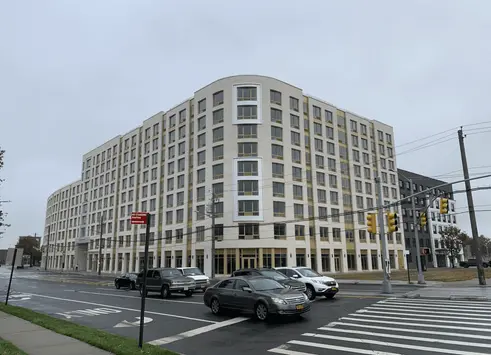 The Fountains (The Arker Companies)
The Fountains (The Arker Companies)
The Fountains
Neighborhood: East New York
Building Type: Affordable Senior Community
Developers: The Arker Companies
Designer: Aufgang Architects
In 2021, construction was completed on The Fountains, a six-building, 1,163-unit complex that was built as part of the Vital Brooklyn initiative. A total of 200 units were set aside for seniors over age 62, with 60 of these set aside for homeless seniors. The complex was constructed to meet Enterprise Green Community standards, and amenities include on-site supportive services, a public plaza, and over 20,000 square feet of ground-floor retail space.
The Bishop Philius and Helene Nicolas Senior Residence - 1488 New York Avenue
Neighborhood: East Flatbush
Building Type: Affordable Senior Living Rental
Developer: Evangelical Crusade Christian Church and BEL Community Development
Designer: Heritage Architecture
The Bishop Philius and Helene Nicolas (BPHN) Senior Residence project consists of 88 studio residences as well as amenities that include a community room, common area space for residents, laundry facilities and on-site social services. An additional 10,575 square feet community service facility is located on the first and cellar levels of the building.
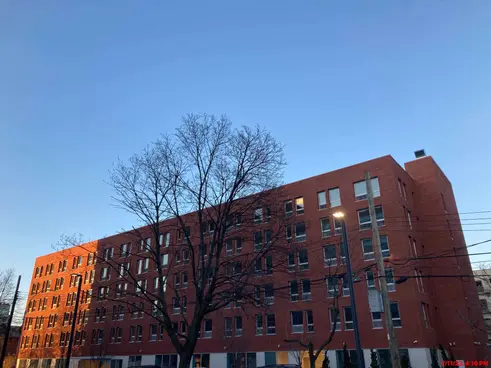
Bishop Rene Valero Apartments
Neighborhood: Astoria
Building Type: Mixed-Income Housing
Developer: Catholic Charities
Designer: Dattner Architects
Bishop Rene Valero Apartments is a 102-unit affordable project designed for low-income seniors and the formerly homeless. The project was financed through the Senior Affordable Rental Apartments program (SARA) and the Low Income Housing Tax Credit program of the New York City Department of Housing Preservation and Development, and renderings depicted a red brick facade. The building will be pet-friendly and offer such amenities as a central laundry room, elevator, common area Wi-Fi, and the services of an on-site resident manager. It will also offer supportive services like daily hot meals, educational forums, fitness classes, senior case management, and referral services.
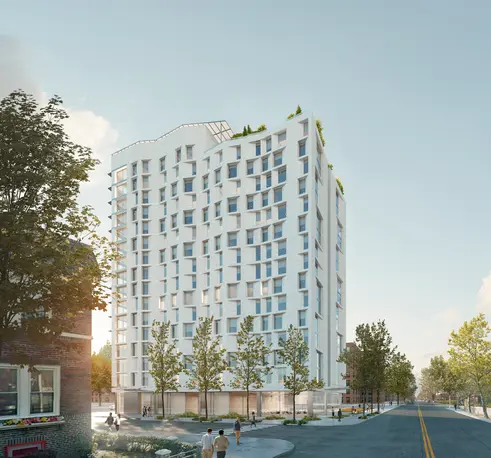 Rendering courtesy of Magnusson Architecture + Planning
Rendering courtesy of Magnusson Architecture + Planning
Casa Celina - Watson and Thieriot Avenues
Neighborhood: Soundview
Building Type: Affordable Senior Living Rental
Developers: Xenolith Partners, The Kretchmer Companies, ELH Mgmt. and JASA
Designer: Magnusson Architecture + Planning
In spring 2019, plans were announced to construct a 16-story senior housing building comprised of 200 senior apartments on the grounds of the Sotomayor Houses in the Soundview neighborhood of the Bronx. Amenities include an exercise/fitness room, laundry room, lounge areas throughout the building, a landscaped rooftop, and 3,350 square feet of community space accessible to NYCHA residents and the surrounding community.
Coming Soon
The Norfolk, 60 Norfolk Street
Neighborhood: Lower East Side
Building Type: Affordable Senior Living Community
Developer: Gotham Organization
Designer: Dattner Architects
As part of a new Broome Street development, The Norfolk will contain 115 senior housing units and a full-floor amenity suite with a lounge, game room, fitness center, and social services office. The building will rise on the former site of Beth Hamedrash Hagodol synagogue, which was destroyed in a fire in 2017, and the new building will also include worship space and a cultural heritage center for the synagogue.
161 Broome Street, Lower East Side
Neighborhood: Lower East Side
Building Type: Affordable Senior Housing
Developer: Grand Street Guild
Designer: Handel Architects
Just south of the Essex Crossing Development and near the forthcoming senior housing venture 60 Norfolk Street, the nonprofit Grand Street Guild is spearheading the development of two 15-story buildings that will bring 400 units of affordable housing to the Lower East Side. A sizeable 150 of all units will be reserved for seniors. The designer at hand is Handel Architects and a rendering shows a rather brutal red-brick design with a formidable street presence.
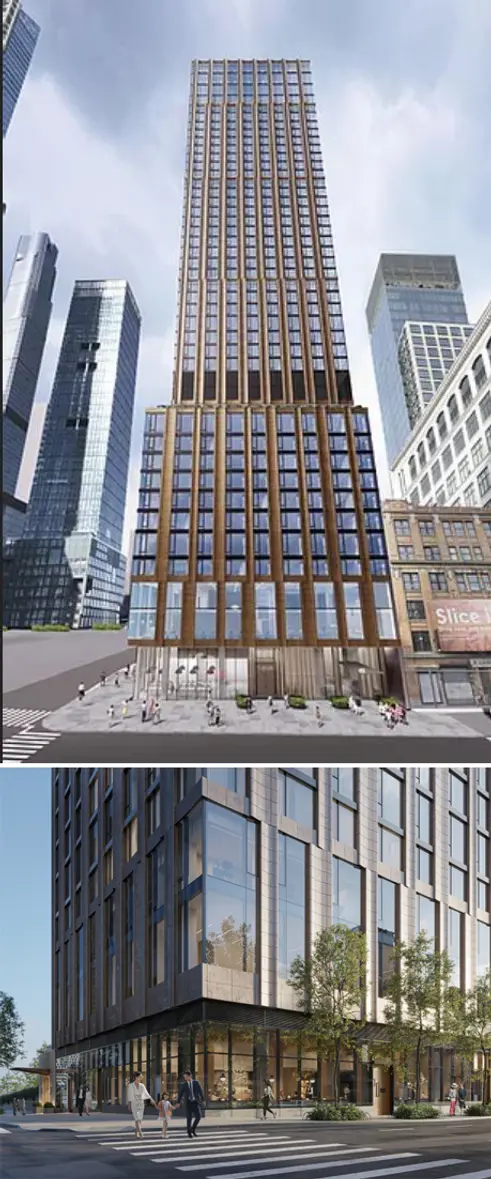 Coterie Hudson Yards,
Coterie Hudson Yards,
Coterie Hudson Yards, 485 Tenth Avenue
Neighborhood: Midtown West
Building Type: Luxury Senior Living Community
Developer: Related Cos., Atria Senior Living, Spitzer Enterprises, and Welltower
Designer: Handel Architects
Coterie Hudson Yards is a ground-up high-rise in the thick of the Hudson Yards area offering white-glove service, a state-of-the-art Equinox fitness center, and a variety of indulgent dining experiences. We’re not talking about 35 Hudson Yards this time - Coterie Senior Living will bring its first East Coast location to this rapidly transforming neighborhood. The building will offer independent living, assisted living options, and a dedicated memory care suite.
Residences will feature floor-to-ceiling windows. In addition to the fitness center and restaurants, amenities will include a library, a screening room, lush gardens, and a wraparound terrace with spectacular skyline views. The New York Post describes it as "not your grandfather's retirement home."
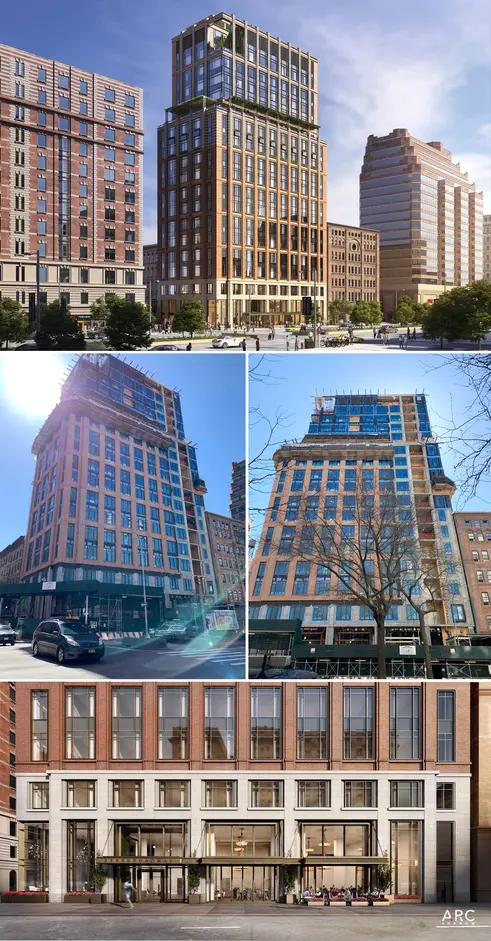
2330 Broadway
Neighborhood: Upper West Side
Building Type: Senior Living Community
Developer: HInes/Welltower
Designer: SLCE Architects
Situated at the southeast corner of West 85th Street and Broadway on the Upper West Side, 2330 Broadway is a state-of-the-art 140,170-square-foot, 17-story senior living, and memory care community. Upon completion, the building will contain 162 units and amenities such as a spa, a homeopathic care center, a rooftop garden, and a “bistro,” where residents can retreat for refreshment and communal activities. Construction topped out last year, and a recent site visit saw the brick facade well on the way up.
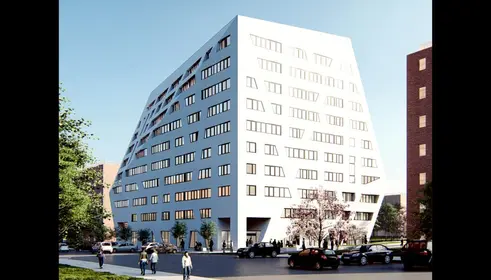 Atrium at Sumner (Studio Libeskind)
Atrium at Sumner (Studio Libeskind)
Atrium at Sumner
Neighborhood: Bedford-Stuyvesant
Building Type: Mixed-Income Housing
Developers: Selfhelp Community Services, Riseboro Community Partnership, and Urban Builders Collective/Lettire
Designer: Studio Libeskind
Atrium at Sumner is taking shape on the Sumner Houses campus as part of "Seniors First," a component of Housing New York 2.0 that builds senior housing on NYCHA land. Renderings depict an angular white facade and bold diagonal lines, and the project is being constructed to meet Passive House standards.
Upon completion, the 190 units will include 57 units for homeless seniors and 123 apartments for households at or below 50 percent of the Area Median Income (AMI). Amenities will include a community garden for residents, a central atrium, a year-round indoor garden, outdoor seating adjacent to the building’s entrances, an exercise room, and classrooms, conference rooms, and a large multi-purpose room. Additionally, a new playground, walking paths, lighting, and seating are planned for the open space next to the building. Completion is estimated for 2023.
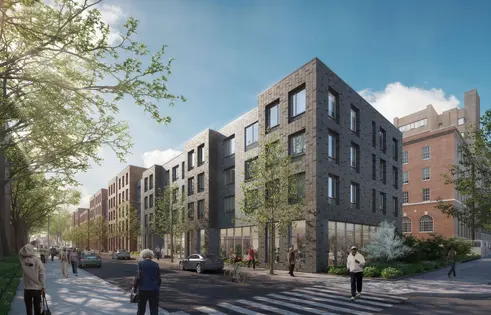 Kingsbrook Estate (Dattner Architects)
Kingsbrook Estate (Dattner Architects)
Kingsbrook Estate
Neighborhood: Prospect Lefferts Gardens
Building Type: Mixed-Income Housing
Developers: Monadnock Development, CB-Emmanuel Realty, and Brooklyn Community Housing and Services
Designer: Dattner Architects
On the former Jewish Medical Center North campus, a three-building affordable housing complex is taking shape as part of the Vital Brooklyn initiative. Three buildings are being demolished and replaced, and the Leviton Building is being redeveloped to accommodate housing.
Upon completion, the complex will offer 266 units for older adults and disabled veterans with a range of incomes. A 7,000-square-foot PACE Center will provide all-inclusive senior care. Amenities will include on-site laundry, storage, on-site health services, community rooms, children’s playrooms, outdoor kitchens, indoor teaching kitchen, outdoor exercise equipment, and free Wi-Fi. It will also be enhanced by such energy-efficient features as solar photovoltaic panels and green roof systems.
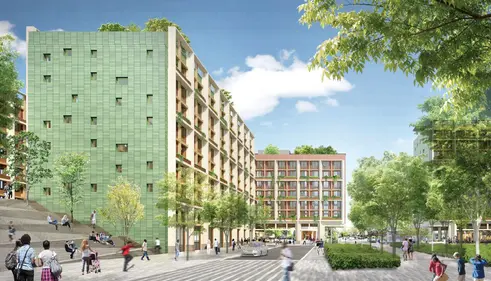
681 Clarkson Avenue
Neighborhood: East Flatbush
Building Type: Mixed-Income Housing
Developers: Almat Urban, Breaking Ground, Brooklyn Community Services, the Center for Urban Community Services, Douglaston Development, Jobe Development, and the Velez Organization
Designers: Adjay Associates and Studio Zewde
In July 2021, the governor's office announced a winning proposal to redevelop 7.2 acres of the Kingsboro Psychiatric Center. The new development will include 900 units of affordable and supportive housing (including senior housing), a 10,000-square-foot grocery store, and a 7,000-square-foot community hub with computers and space for after-school programs and workforce training. Amenities are set to include a basketball court, areas for urban farming, a greenhouse, free high-speed Wi-Fi, and exercise rooms; renderings depict abundant greenery and public outdoor space. Additionally, two new homeless shelters will be built to replace the shelters built in the 1930s.
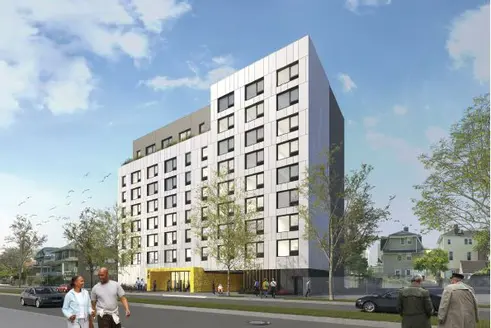 Rendering (Think Architecture + Design)
Rendering (Think Architecture + Design)
Arverne Senior Housing
Neighborhood: Arverne
Building Type: Senior Housing
Developers: Brisa Builders and God’s Battalion of Prayer Properties
Designer: Think Architecture + Design
At the end of 2021, the mayor's office approved a rezoning proposal to bring an 84-unit senior housing building to Beach 67th Street in Arverne, Queens. Renderings in the proposal package depicted a terraced roof deck, a rear yard garden, and a rear parking lot for six vehicles. The rezoning will also allow for a charter school on Beach 67th Street.
Sol on Park, Morris Houses, Bronx
Neighborhood: Morrisania
Building Type: Affordable Senior Living Community
Developer: NRP Group, Selfhelp Realty Group, and Foxy Management
Designer: Magnusson Architecture + Planning
The New York City Department of Housing Preservation and Development, the NYC Housing Authority (NYCHA), and the NYC Housing Development Corporation recently announced plans to build a Sol on Park, a 15-story mixed-use building containing 195 deeply affordable senior housing units, within the Morris II public housing development as part of the Seniors First initiative. Senior households earning up to 50 percent of the Area Median Income (or approximately $41,800 annually for a single occupant) will be eligible to apply, and a portion of units will be set aside for NYCHA residents and seniors experiencing homelessness. All households will receive project-based Section 8 vouchers.
Renderings depict a modern building with massive windows, and the homes inside are designed to enjoy abundant light and distinct spaces for cooking, dining, living, and sleeping. In addition to the housing units, the project’s community space will include a Union Community Health Center, the Green Bronx Machine’s National Health & Wellness Center dedicated to nutritional education, the SUNY Bronx Educational Opportunity Center, and Selfhelp’s Home Care Program and Training Center for Home Health Aides. The building is aiming for LEED Platinum certification, Energy Star certification, and the highest rating from Fitwel.
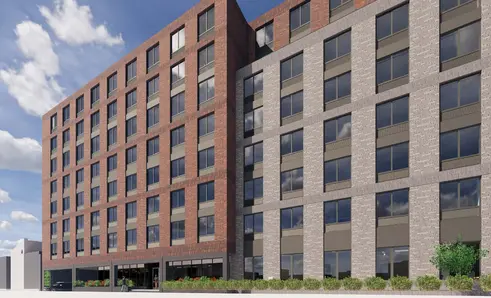
Parkchester Gardens Apartments
Neighborhood: Parkchester
Building Type: Affordable Senior Living Community
Developers: Olshan Properties and O'Connor Capital Partners
Designer: Dattner Architects
In April 2021, construction began on Parkchester Gardens, a senior affordable housing development near the New York Botanical Garden and Bronx Zoo. Selfhelp Community Services will provide on-site services and programming, and residential amenities will include a fitness center, lounge, package lockers, bike storage, and outdoor areas. All apartments will feature luxury vinyl tile, Hanstone countertops, and stainless steel appliances, including dishwashers.

915 Elsmere Place
Neighborhood: Tremont
Building Type: Mixed-Income Community
Developer: Stagg Group
Designer: Marin Architects
As of this writing, an affordable housing lottery is underway for 39 units are 915 Elsmere Place. The apartments set aside for residents earning 80 percent of the Area Median Income are reserved for households with at least one member aged 62 and older. The building will welcome pets, and amenities are set to include an elevator, gym, and central laundry room.

2850 Webster Avenue
Neighborhood: Bedford Park
Building Type: Affordable Senior Housing Community
Developer: Douglaston Development
Designer: Stephen B. Jacobs Group
Down the block from the New York Botanical Garden, a new senior housing facility has risen on a former parking lot. The building staff will include a 24-hour superintendent, part-time security, and social services. Amenities are set to include an elevator and central laundry room.
{{error}}
More Rental Deals
- Leasing Updates View All
- Grand Opening View All
- Free Rent View All
-
Special Offers
-
Avalon Fort Greene offering discounts on select units; No-fee rentals from $2,845/month
-
Security Deposit Discounts at Beatrice Apartments in Chelsea; No Fee Rentals from $3,855/Month
-
East Harlem's The Heritage on Central Park: Renovated Rentals with Incentives from $2,595/Month
-

Contributing Writer
Cait Etherington
Cait Etherington has over twenty years of experience working as a journalist and communications consultant. Her articles and reviews have been published in newspapers and magazines across the United States and internationally. An experienced financial writer, Cait is committed to exposing the human side of stories about contemporary business, banking and workplace relations. She also enjoys writing about trends, lifestyles and real estate in New York City where she lives with her family in a cozy apartment on the twentieth floor of a Manhattan high rise.

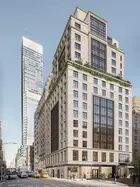
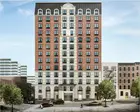
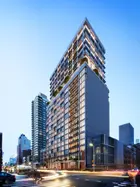
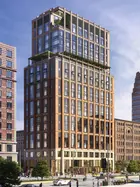

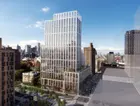

 6sqft delivers the latest on real estate, architecture, and design, straight from New York City.
6sqft delivers the latest on real estate, architecture, and design, straight from New York City.
